
What Are Heat Loss and Heat Gain Calculations?
Last Updated: Apr 7, 2025When homeowners are planning on building a new home or making major renovations to their existing house, the calculations that most of us rely on are related to economics. For example, do we have enough money in the bank account to cover these expenses? How quick will the payback period be for these energy efficiency renovations? Might there be rebates or tax incentives available for the renewable energy system I want to install? And the list goes on.
These money-based calculations are undoubtedly crucial. They help homeowners discover that sustainable upgrades to their homes are almost always cost-effective. Most of the measures related to the construction and installation of these sustainable upgrades are usually left to architects, energy consultants, and other specialists. Even if you have forgotten most of the calculus, trigonometry, and other high-level math you learned in high school, heat loss and heat gain calculations are relatively quick to calculate for the homeowner.
In this short article, Rise explains the purpose and importance of heat loss and heat gain calculations. We then describe how even the most "math-challenged" amongst us can quickly and effortlessly use these calculations to size HVAC equipment for your home correctly.
Table of Contents
- What Are Heat Loss and Heat Gain Calculations Used For?
- Why Are Heat Loss and Heat Gain Calculations Important For Homeowners?
- Can You Perform Heat Loss and Heat Gain Calculations Yourself?
- What Information Do You Need to Perform Heat Loss and Heat Gain Calculations?
- What Software Exists for Heat Loss and Heat Gain Calculations?
- Is It Worth Discussing Heat Loss and Heat Gain Calculations With Your Contractor?
- Are Heat Loss and Heat Gain Calculations Useful For Various House Certifications?

What Are Heat Loss and Heat Gain Calculations Used For?
A well-maintained furnace will generally last for somewhere between 15 and 20 years. However, air conditioners typically have slightly shorter lifespans at anywhere between 10 and 15 years. Unfortunately, this lifespan means that most homeowners will have to replace their essential HVAC equipment several times during their lifetime.
According to the US Department of Energy, our homes' heating and cooling account for at least 48 percent of total household energy usage. Fortunately, newer models of air conditioners, furnaces, and energy-efficient heat pump drastically lower the amount of energy we need to purchase to keep our homes at a comfortable temperature throughout the changing seasons.
Regrettably, many of the efficiency advantages of newer and improved HVAC equipment are nearly lost when they are not sized correctly for individual homes. Many HVAC companies and private contractors will routinely recommend larger units to boost their profit margins and to "be on the safe side" in the event of extreme weather events.
When an air conditioner or furnace is oversized, this leads to increased energy consumption and less efficient heating or cooling (we will detail this issue in the next section). Therefore, heat loss and heat gain calculations are used by HVAC technicians when consulting on the best unit for a home. However, many companies will revert to generic formulas that only consider the home's generalized square footage.

Why Are Heat Loss and Heat Gain Calculations Important For Homeowners?
As we explained above, oversized central furnaces and central air conditioners almost always result in less efficient heating and cooling. This sizing problem, of course, also leads to higher energy bills every month. Instead of blindly trusting an HVAC technician's recommendations, homeowners can utilize heat loss and heat gain calculations to appropriately size the most efficient heating or cooling unit for their home.

If you are undergoing a more thorough energy efficiency retrofit of your home, hiring an independent home energy auditor is an excellent place to start. An energy auditor will utilize heat loss and heat gain calculations and dozens of other computations and estimates to design the most effective strategies for improving your home's energy efficiency and thermal performance. Besides identifying areas of low insulation in your walls, ceiling, and foundation, an energy auditor will also be able to recommend the most efficient furnaces, air conditioners, and ventilating equipment to keep your home comfortably and efficiently heated and cooled.

Homeowners can expect to pay between $300 and $700 for a thorough energy audit. In many cases, this expense will pay for itself in future energy savings and help you identify the most cost-effective and adequately sized HVAC equipment for your home. As an independent and third-party contractor, your energy auditor should also be able to explain in detail what these calculations entail and offer you unbiased advice and product or brand suggestions.

Can You Perform Heat Loss and Heat Gain Calculations Yourself?
For homeowners who either don't want to pay an extra $300 to $700 for a private energy auditor or who prefer to do things themselves, heat loss and heat gain calculations can be undertaken on your own. Heat loss calculations determine the total or maximum amount of heat measured in either BTU/hour or kW needed to keep a home comfortably heated. This calculation depends on several factors, including:
- Extreme outdoor winter temperatures
- How sealed your building envelope is
- The volume of warm air exhausted by fans
- Level of insulation
- Type of windows, doors, and other building materials
Similarly, heat gain calculations determine the optimum amount of cooling in either BTU/hour or tons needed to manage indoor temperature and humidity during the warmer months of summer. This calculation includes factors such as:
- Extreme outdoor summer temperatures
- The quality of your building envelope
- The volume of hot air that enters to make up for exhausted air
- Type and efficiency of insulation
- Amount of solar gain through windows and skylights
- Internal heat gains from appliances and home occupants
What Information Do You Need to Perform Heat Loss and Heat Gain Calculations?
For math wizards, a basic heat loss or heat gain calculation is Q=U*A*ΔT. If this looks like a foreign language to you, the formula can be explained as:
Heating and Cooling
Find a wide variety of researched and vetted heating and cooling products that help address home comfort.

Stiebel Eltron CON 300-2 Premium Wall-Mounted Convection Heater - 202030
Stiebel Eltron
Out of Stock
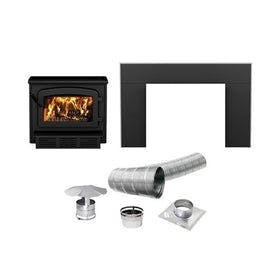
Drolet Escape 1800-I Wood Stove Insert Trio (25ft) DB03127K
Drolet
Out of Stock
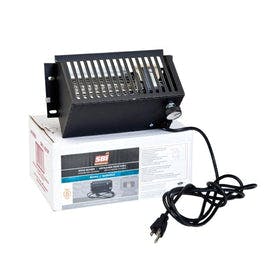
Drolet Ultra-Quiet 100 CFM Blower With Variable Speed Control - AC02050
Drolet
In Stock
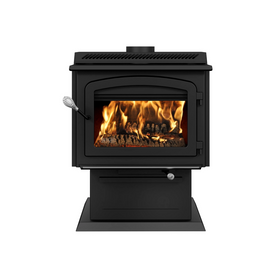
Drolet HT-3000 Wood Burning Stove DB07300
Drolet
Out of Stock

Drolet Escape 1500-I Wood Insert Trio (25 FT) DB03137K
Drolet
Out of Stock

Drolet Escape 1800-I Wood Insert DB03125
Drolet
Out of Stock
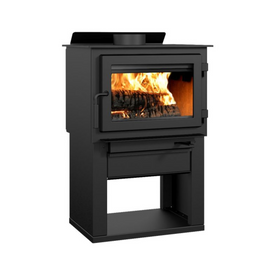
Drolet Deco II Wood Stove DB03205
Drolet
In Stock

Stiebel Eltron CON 150-1 Premium Wall-Mounted Convection Heater - 202026
Stiebel Eltron
In Stock

Drolet Escape 1800-I Wood Insert Trio (35 FT) DB03128K
Drolet
Out of Stock
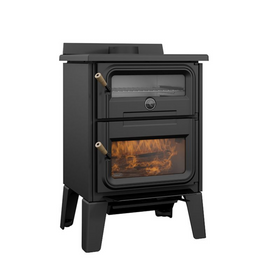
Drolet Bistro Wood Burning Cookstove DB04815
Drolet
In Stock
Heat loss or gain (Q) is the result of: the U Value of the building materials (U) x the surface area of the building material (A) x the difference in outdoor and indoor temperatures (ΔT)
U-Values are usually associated with energy-efficient windows. However, all building materials can calculate their U-value, which is a measure of thermal transmittance. Thermal transmittance is defined as "the rate of transfer of heat through a structure (which can be a single material or a composite), divided by the difference in temperature across that structure."
To make matters even a bit more complicated, accurate heat loss or heat gain calculation should also include:
- A combination of the R-values of the various building materials with the exposed surface area
- An estimate of the adequate hole size in the building envelope (this is measured by an energy auditor using a blower door test)
- The total glass area, shading, and direction it faces relative to the sun
- The BTUs per hour provided by lighting, appliances, and other equipment
- The "people load," measured in BTUs per hour, and
- The ventilation load for fresh air entering and exhaust air leaving the building
What Software Exists for Heat Loss and Heat Gain Calculations?
At this point, the $300 to $700 charged by an independent energy auditor might be seeming like quite a deal. However, if you don't want to tackle the calculations independently, there are also online resources available to get you your results.

High SEER HVAC Load Calculator:
This simple to use and free online calculator allows homeowners to determine the best-sized air conditioner for their home. The calculator requires you to input information related to your climate region (a map is provided), the square footage you want to cool, insulation grade, amount of sun exposure, the number of occupants, the number of windows, and other detailed information. The output of this calculator offers a calculated cooling load and a recommended equipment capacity measured in BTUs.
Omni Calculator for Heat Loss:
Omni Calculator provides another free online tool. This software calculates the total heat loss and the power required for a central furnace for your home. For the more accurate “Advanced Mode,” you'll need to input information on the area of the house or room you want to heat, the family's features, the U-Value of windows and doors, and the ambient and internal temperatures. A valuable feature of this calculator is the ability to quickly change between different measurements, such as BTU/h, kW, MW, and more.

HeatCAD 2020:
For homeowners who want a more detailed heat loss or heat gain calculation and know how to use basic architectural design software, HeatCAD 2020 is a great option. This drawing-based software calculates residential heating and cooling loads. It incorporates advanced design features, including integrated load calculations, automatic detection of unheated surfaces, and 3D CAD views. This software comes with a free, 30-day trial.
Is It Worth Discussing Heat Loss and Heat Gain Calculations With Your Contractor?
The National Renewable Energy Laboratory (NREL) finds oversized HVAC equipment is responsible for higher energy use rates due to increased on/off cycling and parasitic off-cycle power. Essentially, the extra power of larger central air conditioners and furnaces will more quickly get your home to its desired interior temperature, thus causing it to cycle on and off more frequently. Unfortunately, this cycling requires extra energy usage and can also negatively affect the lifespan of your HVAC equipment. As a valid comparison, the short bursts of energy that happen with oversized HVAC equipment can be likened to the worsened gas mileage drivers get when driving through stop-and-go traffic during rush hour.
Though your contractor may charge extra money for a detailed heat loss and heat gain calculation, this should ensure that you properly size the HVAC equipment for your home renovation. This step usually results in lower upfront costs as smaller equipment is generally cheaper. It will also save you money in the long run through increased operational efficiency.
Finally, an oversized system will result in reduced comfort. An oversized air-based system will result in uneven temperatures throughout the home unless the fan is set to run independently of the need to heat and cool. In addition, an oversized air conditioner won't be able to remove as much humidity that is responsible for much of our summertime discomfort.

Are Heat Loss and Heat Gain Calculations Useful For Various House Certifications?
Heat loss and heat gain certifications are usually part of a more comprehensive energy performance certificate required by LEED and other sustainable home certifications. These certification programs can help homeowners apply for national and local tax rebates and other necessary zoning allowances. The couple hundred extra dollars you pay for an in-depth heat loss or heat gain calculation should be able to pay for itself down the road.
This article has been reviewed by:
David Elfstrom of Elfstrom Energy Solutions.
Tobias Roberts
Tobias runs an agroecology farm and a natural building collective in the mountains of El Salvador. He specializes in earthen construction methods and uses permaculture design methods to integrate structures into the sustainability of the landscape.
